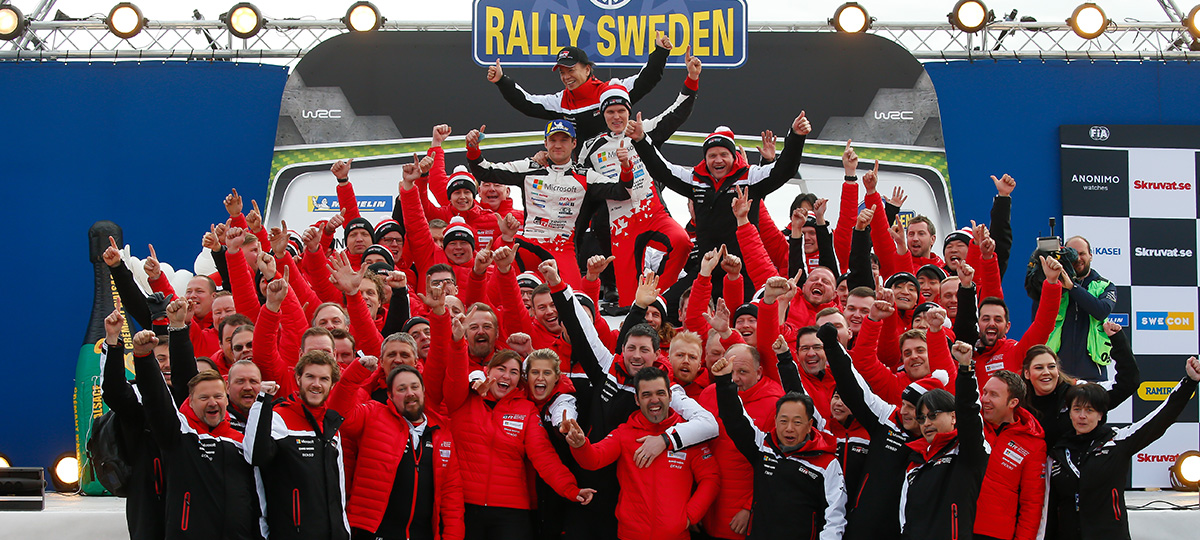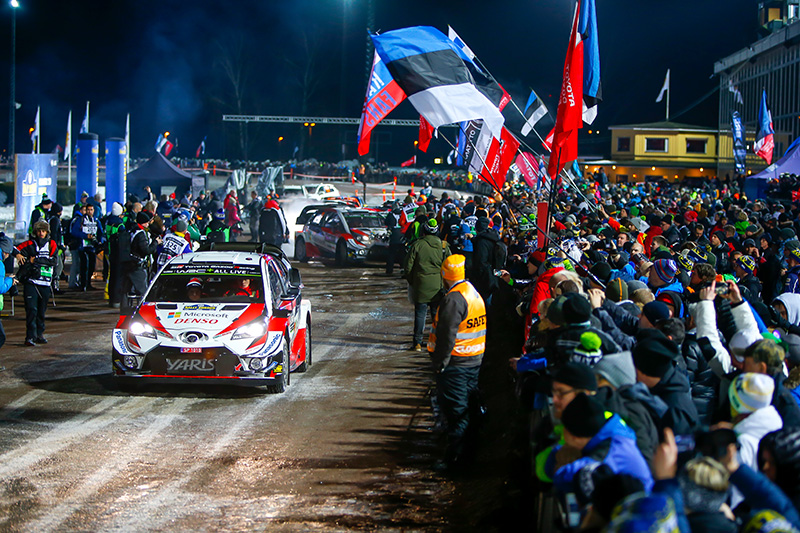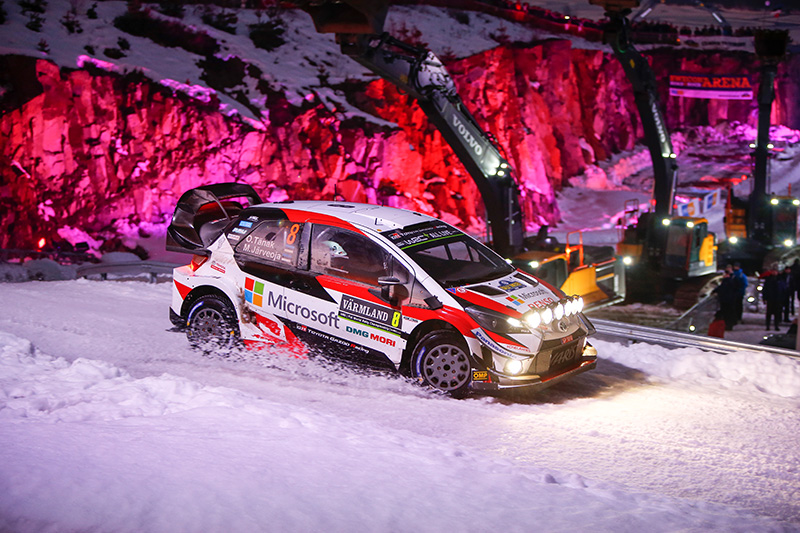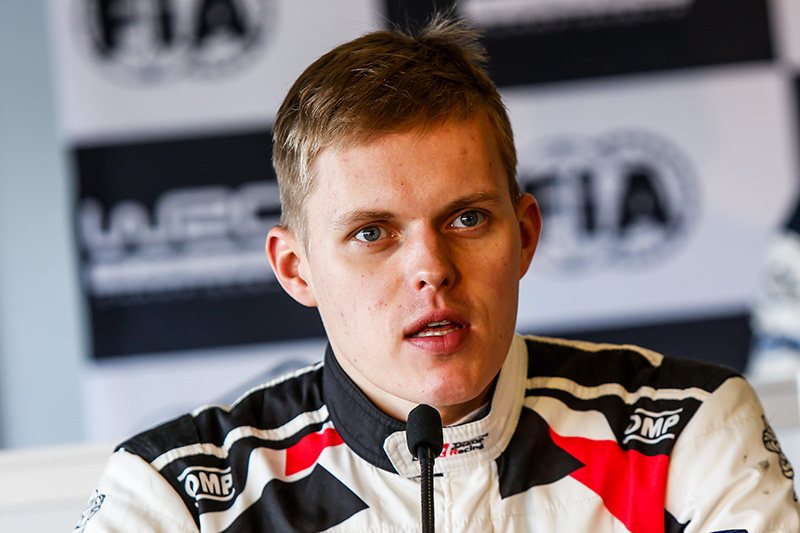2019 Rd.2 RALLY SWEDEN
WRC 2019 ROUND 2 RALLY SWEDEN

SUMMARY REPORT
Thanks to Ott Tänak’s third place at Rallye Monte-Carlo, the TOYOTA GAZOO Racing World Rally Team had made a solid start to the season. The number of rallies has increased by one to 14 this year, and a long, grueling battle is expected until the season ends in November with Rally Australia. Yet Shigeki Tomoyama, President of the GAZOO Racing Company, had an intuition that Rally Sweden, the second event of the season, would prove pivotal in this season’s fight for the championship; he believed that winning or losing this rally would have a significant influence on the rest of the season.

Tänak shared Tomoyama’s intuition. In order to become world champion in the WRC—a series in which top-level drivers engage in fierce competition—he would have to fight for victory in every rally. In particular, it was crucial that he won those rallies that suited both his driving style and his rally car—and Rally Sweden was one of those rallies. In 2017, Jari-Matti Latvala steered the Yaris WRC to its inaugural victory at Rally Sweden. Despite being a full-snow rally, Sweden’s Special Stages boast the second or third fastest average speeds of the season. This suits the Yaris WRC, which excels on high-speed stages due to its advanced aerodynamics.

However, last year’s event took place in heavy snow and, hampered by an unfavorable starting order, the Yaris WRC was unable to show its true potential. The three drivers who had stood atop the podium at the season-opening Rallye Monte-Carlo started first, but these early runners were forced to act as snow-sweepers in freshly-fallen snow, and incurred significant time-losses. Last year, Tänak and Latvala, who had finished second and third at Monte-Carlo, had been determined to win in Sweden, but eventually finished a disappointing ninth and seventh respectively. For this reason, the two teammates swore that this year they would win the rally and take the momentum of victory into the following events. In order to this, the team would have to perform to the best of its abilities, and Tänak believed that to maximize the morale Tomoyama would need to be encouraging. He therefore sent the president a video message from the pre-event test: “OMACHI SHITE IMASU (We are waiting for you),” he said, in broken Japanese. Tomoyama was moved by this direct request, and adjusted his busy schedule in Japan to head to Sweden. He was eager to do everything in his power to help the team win.

The team made further improvements to the Yaris WRC and prepared thoroughly. If there was fresh snow on the road surfaces like last year, there was a risk that the snow would block the openings of the car, so increasing weight and reducing aerodynamic performance. Last year, the team covered the entire surface of the rear fenders to prevent the fine fins carved into the back from being blocked up. However, this meant that the Yaris WRC’s aerodynamics—one of its strengths—could not be fully utilized. This year, therefore, the development team redesigned the rear fender so that the fins were spaced further apart and therefore less likely to become blocked up by snow and dirt. The design proved sufficiently effective at the pre-event tests to be used for the rally itself. In order to guarantee stable cooling performance, the team also came up with ideas to prevent the openings at the front of the car from being blocked by snow. In this way, the team implemented all manner of measures at the time before sending the Yaris WRC to Sweden.

Sweden’s stages typically take place amid beautiful snow-white scenes. This year, however, the atmosphere was markedly different. Temperatures began to rise in the week leading up to the rally: the forests lost their whiteness, and large areas of green began to appear. On the forest roads which had been in comparatively good condition due to sufficient snowfall, the surface ice began to melt, grow thin, and reveal patches of brown-colored dirt and gravel. Daytime temperatures during the week frequently rose above five degrees Celsius, with minimum temperatures remaining above zero on an increasing number of nights. The drivers were concerned as they lined up for the rally, saying: “It looks like the conditions are going to be horrendous this year.”

The true forest stages began on Friday, February 15. In the morning, the course conditions of the Special Stages, which ventured into neighboring Norway, were relatively good. Tänak, who was third in the starting order, took advantage of hard-packed ice on the road surfaces to record two fastest times and take the rally lead. Latvala also performed strongly and finished the morning stages in third overall. It was a strong start for the team.

However, the road surfaces had changed dramatically by the start of the afternoon’s stages. The snow and ice had melted as a result of rising temperatures, and now resembled slush ice. Large ruts had also formed since so many cars had driven across the roads, leaving a mix of water and mud to appear beneath the ice. The historic rally cars, which are smaller than the latest World Rally cars and R5 cars, created particularly narrow ruts; these greatly hindered the progression of the World Rally cars, and the drivers higher in the starting order were forced to smooth the ground for the later starters. The top three drivers from Rallye Monte-Carlo were therefore again seriously disadvantaged this year—although for an altogether different reason to 2018.

A similar situation was forecast for Saturday’s afternoon stages. In order to start Saturday’s stages in an advantageous place in the running order, it was absolutely essential to finish Friday towards the top of the overall standings. Melted snow, mud, deep ruts—the drivers at the top of the championship standings attacked in spite of the terrible stage conditions. The two drivers who started ahead of Tänak both lost control of their cars on the tricky roads, went off-course, and plummeted down the standings. However, although Tänak lost top spot, he negotiated the difficulties with expert risk-management, and finished Friday’s stages in second place, just two seconds off the lead. The Estonian had succeeded in securing a favorable position in the running order: on Saturday, he was scheduled to start 13th.

The road conditions had been good during the team’s pre-event tests, and the Yaris WRC handled superbly on the hard-pack snow. However, the team had not had the chance to test the car in melted snow and, for this reason, identifying the optimal setup for such conditions was a major challenge. When it had previously encountered unexpected conditions, the team had often made mistakes in its car setups due to a lack of experience. Now, however, after two years’ experience of actual rallies, the team had acquired the ability to fine-tune the car setups for all manner of conditions. As a result, although the morning and afternoon conditions had differed significantly, the Yaris WRC performed as Tänak expected. Both car and team were increasingly capable of adapting to all manner of conditions, instead of demonstrating just temporary speed.

Saturday morning’s stages started in good conditions and, despite starting low down in the running order, Tänak reeled off a succession of second-fastest times. He overtook his rival and gained the overall lead. Then, as the team had forecast, the afternoon’s stages—which were a re-run of the morning’s stages—took place in extremely tricky conditions, and the drivers starting later had the advantage. When the afternoon’s stages began, Tänak had already opened up a lead of 34 seconds to second place and, driving smoothly, he recorded a further three fastest times. Having secured a larger gap to second place, Tänak eased off the pace and focused on preserving his tires: he had already turned his attention to the final stage of the rally, which would take place the following day. In order to record the fastest time on the final Power Stage, in which bonus championship points are at stake, Tänak concentrated on keeping his tires in as good a condition as possible.

Tänak started the final day of the rally with a massive 55-second lead over second place, and finished the first two Special Stages of the day in fifth and ninth respectively. He then unleashed the full potential of the tires he had been saving on the final Power Stage; indeed, despite being a short stage of just 8.93 kilometers in length, Tänak was fastest by some 3.5 seconds. As planned, the TOYOTA GAZOO Racing World Rally Team driver had taken victory in the Power Stage, thereby adding five bonus points to the 25 he secured for winning the rally. The combined 30 points took Tänak to the top of the drivers’ championship standings.

Kris Meeke was competing in a full-snow rally behind the wheel of the Yaris WRC for the first time. Initially, Meeke lacked confidence on the loose road surfaces—which were distinctly different to the pre-event tests—and he was unable to show his true speed. His position in the starting order was also far from ideal, and this meant he faced unfavorable conditions throughout the weekend. Nevertheless, he remained focused, continued to drive with intelligence, and managed to secure a sixth-place finish. The valuable points he secured saw the TOYOTA GAZOO Racing World Rally Team rise to the top of the Manufacturers’ Championship standings. In difficult circumstances, Meeke had done a spectacular job.

Latvala, meanwhile, veered off-course on Friday’s final stage and got stuck, so giving up his second place in the overall standings. The following day, Latvala took advantage of the Rally 2 regulations to rejoin the event, but he was given a time penalty for doing so; he ended Rally Sweden in 21st overall—a very unsatisfactory result. By winning two Special Stages, Latvala showed he had the pace to compete, and this made his result even more disappointing. However, there is no doubt that if he can complete the final piece of the jigsaw, Latvala will find himself on one of the upper steps of the podium. The TOYOTA GAZOO Racing driver immediately switched his attention to the next event.

Immediately after finishing the Power Stage, Tänak, who was celebrating his first-ever Rally Sweden victory, stood atop the roof of his Yaris WRC alongside co-driver Martin Järveoja and looked to the skies. Before long, they were joined by the smiling team members who had made victory possible. Among them was Tomoyama, who had stayed to watch the team compete to the very end. As the winning manufacturers’ representative, Tomoyama stood on the podium and shared the joy of victory with Tänak and the other team members who had invited him to Sweden. The team had participated in Rally Sweden in the knowledge that it was likely to be an event of particular significance; although the goal of victory had been achieved, both Tänak and Tomoyama fully understood that this was just the first step of a long journey. The team’s next target is to perform strongly at Round 3, Rally Mexico—an event where, for the past two years, they have suffered terribly. For the team, it represents the biggest challenge of the season.

The TOYOTA GAZOO Racing World Rally Team’s senior engineers and mechanics were not present at the victory celebrations. After delivering the Yaris WRC to the first of Sunday’s morning stages, they left Sweden without witnessing the moment of victory. Rally Mexico begins in approximately two weeks’ time, and the senior members of the team were keen to begin preparations for testing as soon as possible. To the members who had not been able to taste the joys of victory in Sweden, Tänak sent a message of gratitude: “Everyone, thank you.”

| Pos | Driver | Co-Driver | Vehicle | Time | |
|---|---|---|---|---|---|
| 1 | Ott Tänak | Martin Järveoja | Toyota Yaris WRC | 2h47m30.0s | |
| 2 | Esapekka Lappi | Janne Ferm | Citroën C3 WRC | +53.7s | |
| 3 | Thierry Neuville | Nicolas Gilsoul | Hyundai i20 Coupe WRC | +56.7s | |
| 4 | Andreas Mikkelsen | Anders Jaeger-Amland | Hyundai i20 Coupe WRC | +1m05.4s | |
| 5 | Elfyn Evans | Scott Martin | Ford Fiesta WRC | +1m08.2s | |
| 6 | Kris Meeke | Seb Marshall | Toyota Yaris WRC | +1m38.8s | |
| 7 | Sebastien Loeb | Daniel Elena | Hyundai i20 Coupe WRC | +1m49.7s | |
| 8 | Pontus Tidemand | Ola Floene | Ford Fiesta WRC | +3m37.7s | |
| 9 | Ole Christian Veiby | Jonas Andersson | Volkswagen Polo R5 | +6m34.0s | |
| 10 | Janne Tuohino | Mikko Markkula | Ford Fiesta WRC | +8m21.4s | |
| 21 | Jari-Matti Latvala | Miikka Anttila | Toyota Yaris WRC | +14m44.4s |
- RELATED TOPICS
-
-
TOYOTA GAZOO Racing World Rally Team
launches 2019 challenge at the Autosport International showThe 2019 FIA World Rally Championship season has been launched today in front of thousands of motorsport fans at the Autosport International show in Birmingham, England. TOYOTA GAZOO Racing World Rally Team is in attendance with its manufacturers’ championship-winning Yaris WRC car and its full squad of drivers and co-drivers. -
WRC 2019 ROUND 2 RALLY SWEDEN Gallery
-